Go to Hawaii bird tour page | USA bird tours | North American trip reports | All our birding tours
31 JANUARY – 09 FEBRUARY 2022
By Jacob Roalef
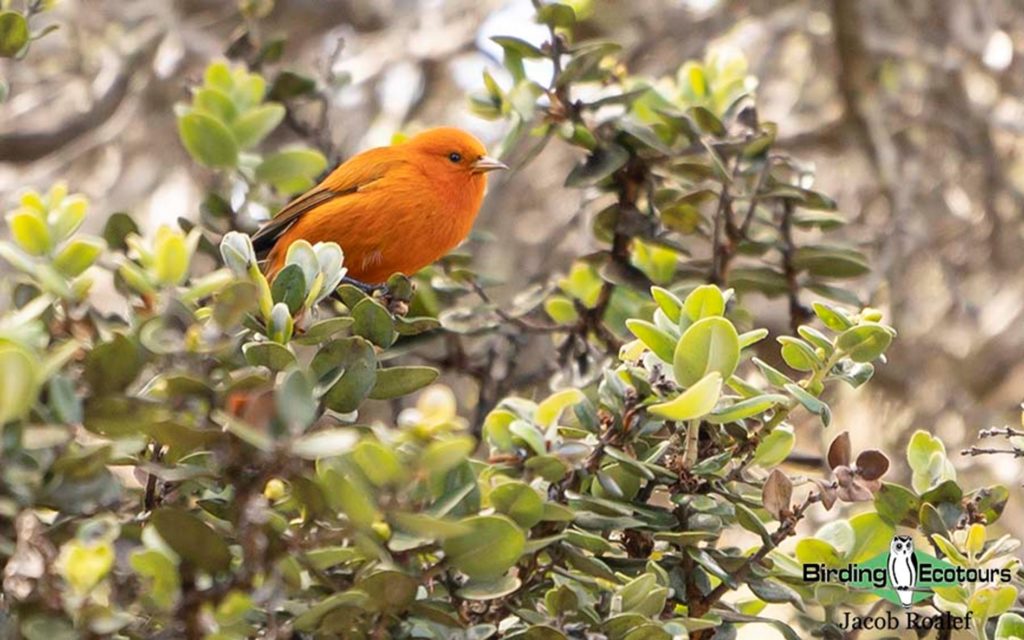
Overview
This ten-day set departure tour of Hawaii commenced in Honolulu, Hawaii on the 31st of January 2022 and concluded in Kona, Hawaii on the 09th of February 2022. The tour visited three of the Hawaiian Islands (Oahu, Kauai, and Hawaii) and visited numerous fantastic birding locations including Koke‘e State Park, Hanalei National Wildlife Refuge, the Kuli‘ou‘ou Valley Trail, Hakalau Forest National Wildlife Refuge, and the Pacific Ocean, on a pelagic out of Kona.
This tour connected with many amazing target birds, including endemic, native, and introduced species, giving us a high-quality list for our ten days in this tropical state. Avian highlights included Akiapolaau, Anianiau, Hawaii Akepa, Oahu, Kauai, and Hawaii Amakihi, Oahu, Kauai, and Hawaii Elepaios, Laysan Albatross, Bristle-thighed Curlew, Omao, Nene, Iiwi, Apapane, Red-footed Booby, White-tailed and Red-tailed Tropicbirds, Hawaiian Coot, White-rumped Shama, Eurasian Skylark, Java Sparrow, and Grey Francolin. We also managed to score a rarity for the state of Hawaii in the form of a vagrant, Red-billed Tropicbird, giving us the sweep of all the world’s tropicbird species.
A total of 81 bird species were seen with three additional heard-only species bringing the total recorded to 84. In addition to the birds, some other animals were spotted including Indian Grey Mongoose, Humpback Whale, Spinner Dolphin, (Hawaiian) Green Turtle, and Gold-dust Day Gecko. Full bird and mammal checklists can be found at the end of the report.
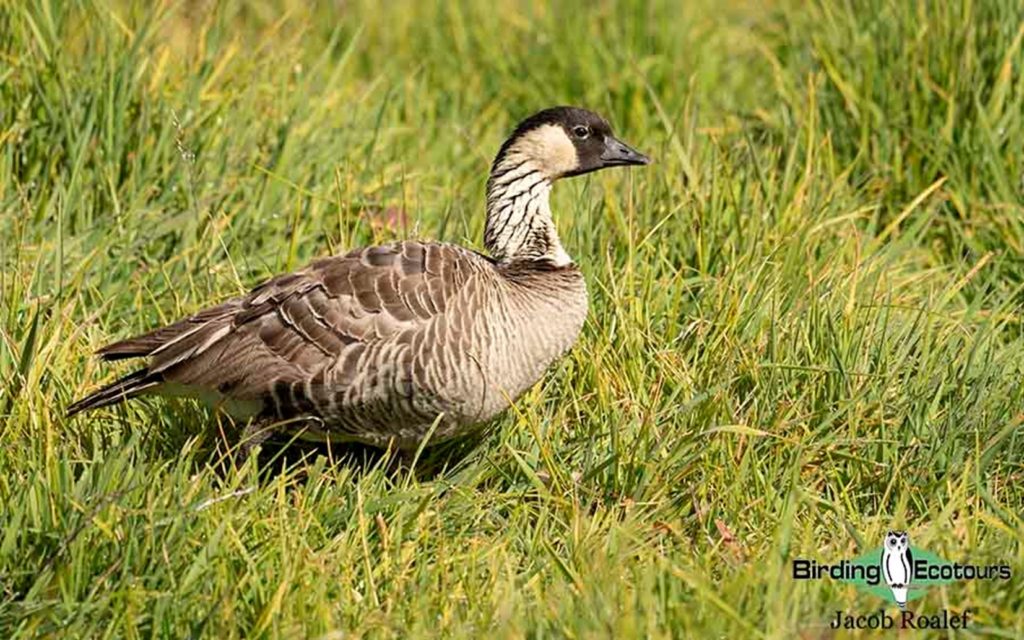
Detailed Report
Day 1, 31st January 2022. Arrival in Oahu
This evening, the group met up at 6 pm for our first dinner together to catch up for some, and new introductions for others. We discussed our excitement for the upcoming days and birds we would hopefully encounter. While sitting outside, a couple of birds flew by including Black-crowned Night Heron and an amazing, bright American Barn Owl! From here, we headed off to bed to get ready for our first full day of birding.
Day 2, 1st February 2022. Oahu Forest and Coastline Birding
Breakfast at the resort was delicious and we shared it with several of the more common bird species as the sun rose. The trees and grounds around us were filled with Zebra and Spotted Doves, Red-crested Cardinal, Warbling White-eye, Red-whiskered and Red-vented Bulbuls, and Common Myna. A great way to start off our first full day of birding. After breakfast, we headed off into the mountains along the Manoa Cliffs Trail. As soon as we stepped out of the vehicles, we were greeted by an Oahu Amakihi, our target bird for the area! It gave us a fantastic showing filled with views in the sun and even sang for us. As we had scored on this fantastic target so quickly, we worked our way back down and over to Kapiolani Park with a quick detour stop in Honolulu to visit an area with nesting White Terns where we got to see this incredible species up close and even spotted a chick in the trees. The park was full of mostly introduced species such as Rose-ringed Parakeet, Yellow-fronted Canary, House Sparrow, and Common Waxbill. Several Pacific Golden Plovers were roaming the grassy fields, allowing up-close views.
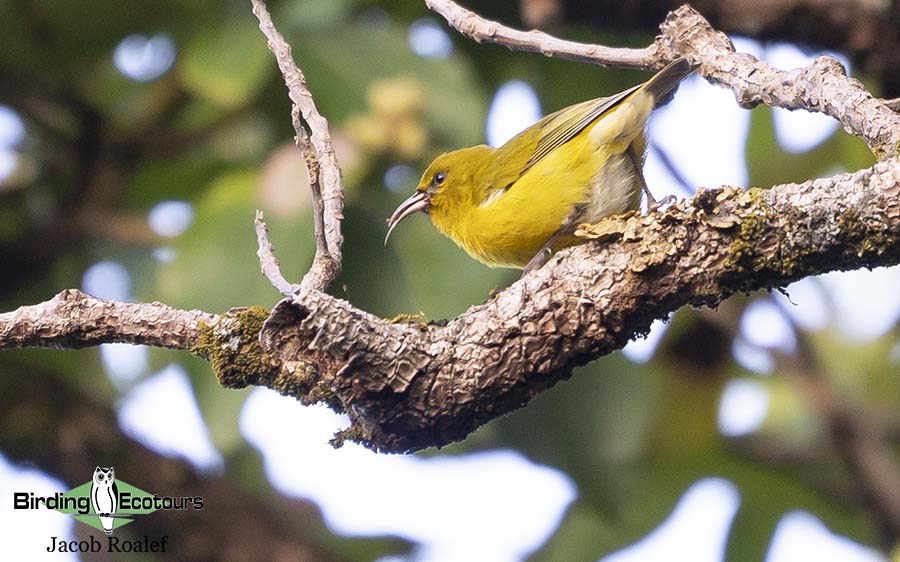
From here we headed off to the Kuli‘ou‘ou Valley Trail to search for the other endemic species on Oahu. While hiking in, we spotted Red-vented Bulbul, White-rumped Shama, and Red-billed Leiothrix, before eventually reaching the first territory for our target. The forest was quiet, but we were patient and diligently searched high and low until eventually an Oahu Elepaio was spotted and gave a few moments of great views for everyone to see! What a score of this Endangered (IUCN) species with estimates of less than 1,300 remaining adults in the wild. We do hope for the recovery of this species as it has been showing some resistance to mosquitoes and avian malaria.
After nailing both Oahu endemic birds, it was time for a tasty lunch by the water at Lana‘i Lookout where we were able to scan and bird. Several Red-tailed Tropicbirds soared around as we ate, and streams of Sooty Terns passed by while Humpback Whales breached in the distant waters. As we wrapped up with lunch, an incredible rarity flew by, Red-billed Tropicbird! This species is a vagrant rarity to Hawaii and as such makes this location the only place to potentially see all three of the world’s tropicbird species. We continued birding and scanning the coast until we made it to our final birding destination of the day, the Ka‘elepulu Wetlands. Here we managed to pick up several more Hawaiian specials including Hawaiian Coot, Black-necked Stilt (Hawaiian subspecies), and Common Gallinule (Hawaiian subspecies). A great way to cap off our first full day of birding this paradise state. We headed back to our hotel and then off to dinner.
Day 3, 2nd February 2022. Oahu – The North Shore
Since we scored the two endemics on the previous day, today we decided to head back to Lana‘i Lookout in the morning to do some more ocean watching and scanning, but first we stopped to experience some delicious malasada. In the parking area next to the malasada truck, a Great Frigatebird flew by in the distance. We made it to the lookout to eat our tasty snacks and do some scanning which yielded more Sooty Terns and Red-tailed Tropicbirds. A few Humpback Whales were spotted again off in the distance as well. We continued to circle around the coastline of Oahu, making stops to scan for anything new, which did produce our first Wandering Tattler. Continuing, we made it to the North Shore, the world–famous surfing destination. As luck would have it, there was a professional surfing competition slated there for this week so many surfer pros were out practicing. The waves were a modest 10-15 feet (3-5 meters), but it was still a neat experience to see people out there surfing. A little further down we stopped at another beach for a restroom and birding check where we spotted the color-bursting Saffron Finch as well as a couple (Hawaiian) Green Turtles taking a mid-morning snooze on the sand.
It was time for a break and a tasty lunch along the North Shore before continuing on to a golf course for our final birding destination of the day. We hiked out along the path, making our way towards the ocean. Pacific Golden Plovers, Zebra and Spotted Doves, and Common Mynas were foraging in the grasses of the course. House and Saffron Finches were seen in the tree lines as we walked along. Eventually we made it to the ocean and a small post-stamp-sized cemetery hosting our target bird for this location, Bristle-thighed Curlew. What an incredible bird and they showed off well for us, posing nicely in the sun on the tombstones. We headed down towards the water where a few in the group had spotted a Grey Francolin dart into the shrubs. As we were searching for that, a giant Laysan Albatross flew by, right overhead! What a stunning and massive bird! A fantastic end to a great day’s birding.
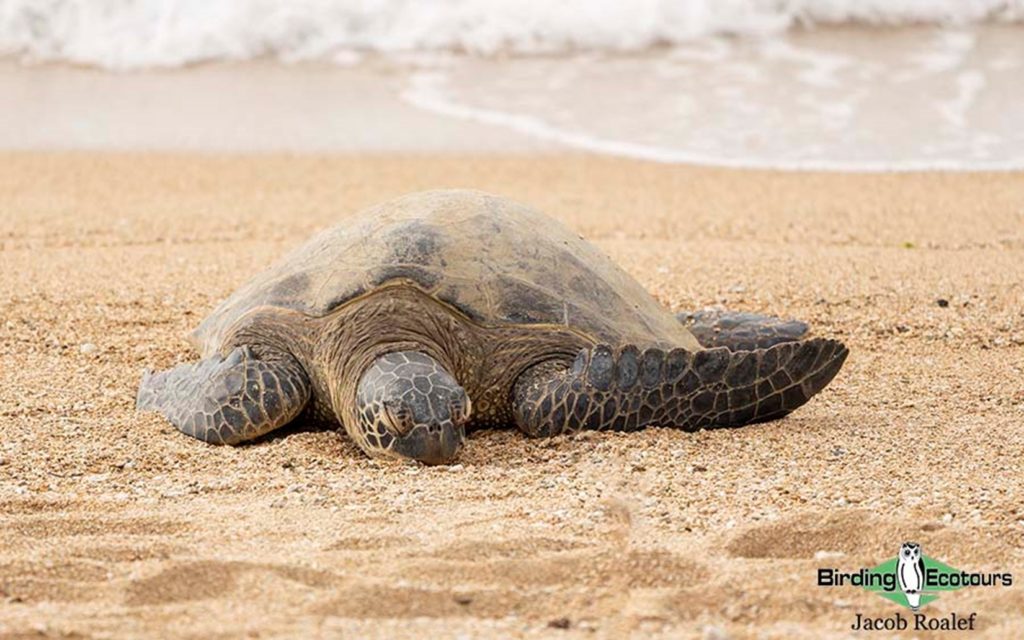
Day 4, 3rd February 2022. Flight to Kauai
This morning we enjoyed a relaxing breakfast at the resort with our local avian friends before heading back to our rooms to pack up our stuff and head to the airport to island hop over to Kauai. Upon arrival, we headed to the resort to drop off our things and then head off for lunch and our first taste of Kauai birding. Our first planned stop was in a private area where we were lucky to experience some of the most breathtaking views of Laysan Albatross. In addition to these amazing birds, we noted our first Nene of the trip as well as the stunning Chestnut Munia. From here we headed off to Hanalei National Wildlife Refuge where we managed to spot our other main target for the day, Hawaiian Duck. This wetland habitat played host to other species as well including Hawaiian Coot, Common Gallinule (Hawaiian subspecies), Black-necked Stilt (Hawaiian subspecies), and Black-crowned Night Heron. Our final birding destination of the day was a relaxing sea watch from Kilauea Point National Wildlife Refuge. We enjoyed some drinks and cookies while we watched a few hundred Red-footed Boobies flying around and gathering nesting materials. Out over the water we spotted Great Frigatebird, Laysan Albatross, and Brown Booby, plus a few Humpback Whales breaching. Such beautiful birds and scenery! We then headed back to the resort for dinner.
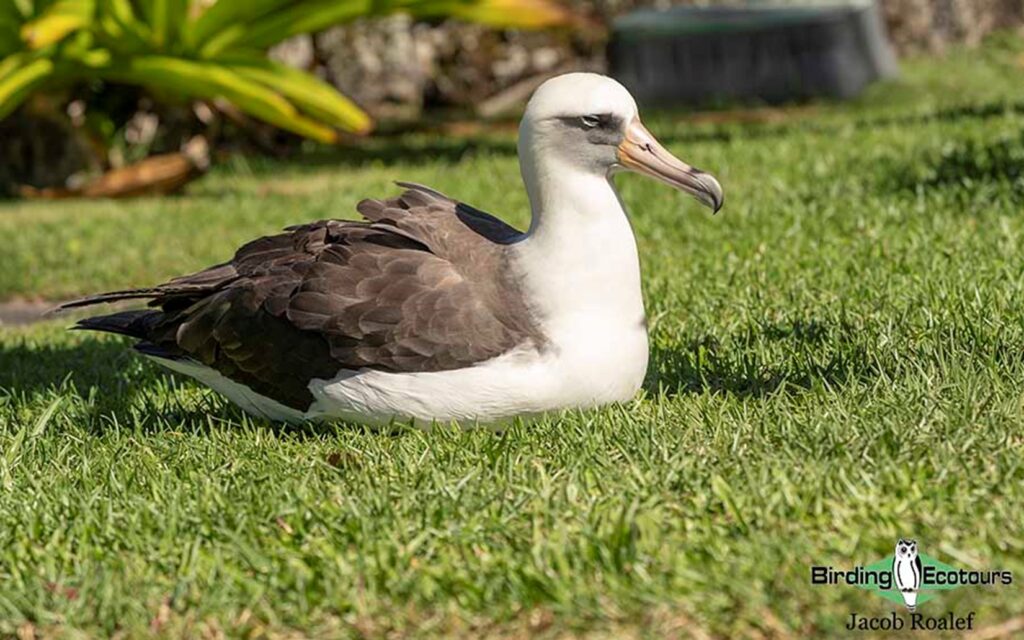
Day 5, 4th February 2022. Full day on Kauai
We began our day at the Waimea Athletic Fields with some breakfast and birding. Many common species were around including Western Cattle Egret, Common Myna, House Finch, and Rose-ringed Parakeet. As we were wrapping up with our meal, we spotted two Erckel’s Spurfowl perched up on a rock outcropping. Then, as we were loading into the vehicles to continue, a White-tailed Tropicbird flew by directly overhead. From here we began our journey up into the mountains of Koke‘e State Park. Full of beautiful scenery and habitats, this huge park proved to be a wonderful birding location. We headed towards the top where a few native plant species remain, and the mosquitoes have not yet reached, in the hopes of finding some of Kauai’s endemic species. We were lucky to spot a Kauai Amakihi quickly upon arrival, which is typically the most difficult to find here! After that, we had great success finding the other target species including Kauai Elepaio, Apapane, and Anianiau. In addition to these native endemics, we managed a few other nice species including Japanese Bush Warbler and White-rumped Shama. After a lovely morning’s birding here, we began our decent and headed towards the lodge. On the way down, we made a few stops in appropriate habitat to search for one more target. Luckily it was calling frequently and finally the Chinese Hwamei made a quick appearance.
We made it to the Koke‘e Lodge and Kanaloahuluhulu Meadow for lunch and to check off a countable Red Junglefowl for our list. Feeling refreshed and energized, we headed out of the mountains and back towards the lowlands and the sea. Our first afternoon stop was at Russian Fort /Fort Elizabeth for restrooms and a quick walk around. Here we managed our first African Silverbill of the trip plus more Scaly-breasted Munia, Northern Cardinal, and Warbling White-eye. From here it was off to the salt ponds and their tidal pools which we scanned thoroughly. We picked up a Ruddy Turnstone which was new for the trip plus Hawaiian Duck, Wandering Tattler, Black-necked Stilt (Hawaiian subspecies) and Great Frigatebird. We also heard a Red Avadavat calling from deep inside the bushes but unfortunately the only appearance it made was when it flew off, never to be seen or heard from again. At this point, we were all feeling hot and tired, so it was time to head back to the resort to clean up, relax, and enjoy dinner after a great day scoring so many target endemics and introduced species!
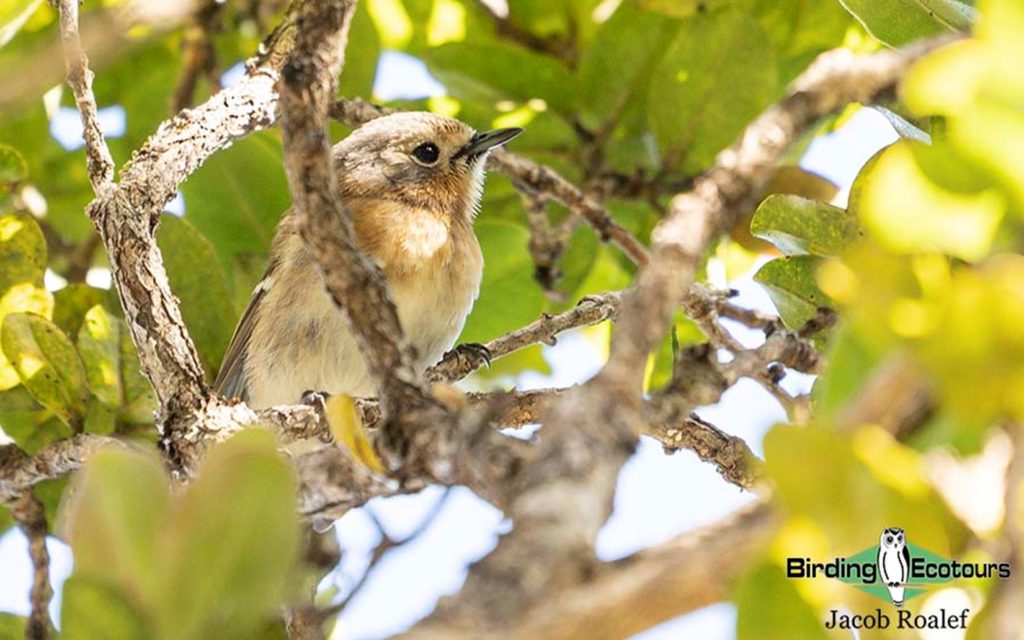
Day 6, 5th February 2022. Kauai and flight to Kona
After breakfast, we headed off for a morning birding session along the Kuamoo Nounou Trail. Things were a bit muddy after some recent rain and the trail was giving a very Jurassic Park feel as we walked along. We started off with Western Meadowlark and Chestnut Munia in a nearby field before climbing in altitude as the forest thickened. Warbling White-eyes and Zebra Doves were scattered throughout, however things were quiet overall. We arrived at the top for a quick rest and to soak in some fantastic views before heading back down. On the way down the trail, we did manage to hear a Greater Necklaced Laughingthrush giving clear calls several times, but it never made an appearance for a visual, as is often the case with this species. Back near the vehicles we spotted a small group of Scaly-breasted Munias, always a cute bird to see.
From here we headed back to the hotel to pack up our things, but we did make a quick stop at ‘Opaek‘a Falls. In addition to the impressive falls, we saw a beautiful White-tailed Tropicbird circling around and exploring the cliffs for nesting locations. After packing up and leaving the resort, we headed off to Nawiliwili Lighthouse near the airport for a bit of lunch and to enjoy some views while waiting for our afternoon flight. Here we enjoyed gorgeous ocean views on a sunny day, planes flying in low overhead, a close flyby of Brown Booby, and some distant Humpback Whales. On our way out, we spotted a Northern Mockingbird, a first for the trip. It was then off to the Lihue Airport from here to catch our flights to the Big Island where we would finish the tour.
Day 7, 6th February 2022. Palila Discovery Trail and Waikoloa
We started off this morning with our first taste of Big Island birding! Our first stop was the town of Waikoloa to pick up some breakfast. On our way out of the parking lot, a Grey Francolin darted across the road and up a pile of gravel where it began to sound off like a car alarm. From here we headed to the local skate park to enjoy our food with the birds. It is always a treat to eat with species such as Rosy-faced Lovebird, Saffron Finch, African Silverbill, and Java Sparrow. We continued to explore the town, keeping our eyes peeled for new species with no luck so we headed up the dry side of Mauna Kea to the Palila Discovery Trail. On the journey up, we managed to spot a Short-eared Owl (Hawaiian subspecies) hunting over the fields before eventually making it to the trailhead at higher elevation. Here we spent the rest of the morning exploring the trails. It was a great to have Hawaii Amakihi as our default species for the day. We searched and searched for the critically endangered Palila which we managed to hear call a few times but never got a visual. Eventually we headed back to the vehicles to take a break and enjoy a picnic lunch before heading back out to continue our searching. Unfortunately, the wind picked up and the afternoon proved even less successful than the morning. Palila has unfortunately dwindled greatly in numbers and has been increasingly difficult to lay eyes on. We decided to call it a day and head back to town and get ready for dinner after a long day of birding.
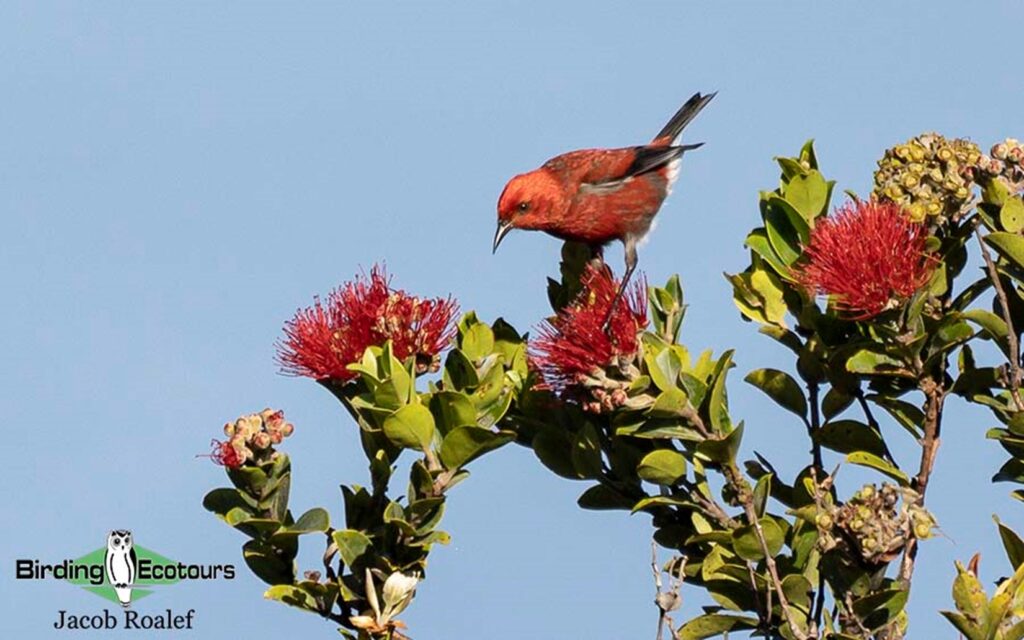
Day 8, 7th February 2022. Hakalau Forest National Wildlife Refuge
We set off early this morning before sunrise as we had a fair bit of distance to travel today. We headed up Saddle Road, splitting the mighty Mauna Lea and Mauna Kea. A quick stop for restrooms and breakfast had us all shivering as we climbed in altitude and the wind was blowing, however, a small covey of California Quails had us feeling a bit warmer. We continued onwards as the sun continued to rise and we began our venture into the highly restricted forest area. Hakalau Forest National Wildlife Refuge located on the wet side of Mauna Kea, is an oasis for native species. Upon arrival, we were treated to a greeting party of nesting Nene. The sun was up now with a few clouds and perfect temperature conditions. Plenty of Apapane and Hawaii Amakihi were singing and flying by overhead as we unloaded and began to prepare for our hike into the forest. It wasn’t long before we managed to score an island endemic, the Hawaiian Creeper! A pair of these amazing birds were working the trees not more than 100 meters from our vehicles. This was a sign for what this gorgeous day had in store for us, and what a day it was!
The I‘iwi were noisy as could be and present throughout our time here. It wasn’t even an hour into our time here that we managed to get amazing views of a pair of Akiapolaau (one adult and one juvenile). These amazing birds were certainly a highlight of the trip for everyone and can be very difficult to find. Continuing onwards we saw a family group of Hawaii Elepaios, the Hilo coast subspecies. A little further up the trail produced maybe the best sighting of the entire tour, eye level views of a male Hawaii Akepa. These little bursts of sunshine typically forage at canopy level, so to see it down low was an incredible treat!
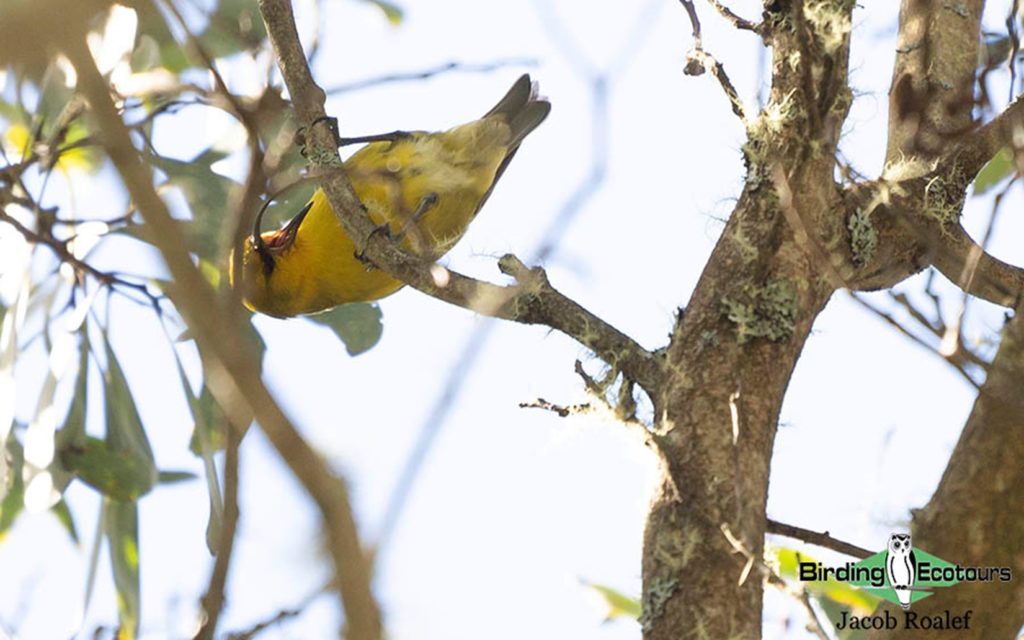
After a splendid picnic lunch, we continued a bit further into the forest as we only had one endemic left to find. The tricky Omao is a thrush that tends to be sneaky in the low brush lines. We managed to hear several of these birds before one finally perched up nicely for us to enjoy. An incredible day at Hakalau, scoring all the endemic species and perhaps the most incredible part, not a single rain drop for the entire day! We said our goodbyes to Hakalau, one of the most amazing birding locations on the planet and began our long journey back to Kona. While driving out, we were scanning and birding. Plenty of Erckel’s Spurfowls and Wild Turkeys were around, and we managed to spot a Ring-necked Pheasant briefly before it flushed. As we approached the end of the gravel road section, we managed to get onto a gorgeous Hawaiian Hawk (Io) that perched nicely for us for several minutes. The rest of the day was spent birding along roads in hopes for a few species we missed on the previous day. We circled around Waikoloa and scored a beautiful Chestnut-bellied Sandgrouse right off the road. From here we headed up to a higher elevation for one last effort on some game bird species and it certainly paid off as we spotted a pair of Kalij Pheasants, a species that became a running inside joke during the tour. A fantastic end to an absolutely incredible day of birding!
Day 9, 8th February 2022. Kona Pelagic
Today we set sail for the open ocean of the Pacific! We gathered just before dawn to prep everything needed for a day spent out on the water and to enjoy a bit of breakfast on land first. We met up with the captains and a few other local birders who were a great help with spotting birds. On our way out of the harbor we noticed a few of the more common species hanging around such as Black-crowned Night Heron, Western Cattle Egret, and Spotted Dove. The waters off Hawaii are a bit strange when thinking of a typical pelagic as there are no gulls or terns trailing the boat. We managed to find a few flyby species mostly consisting of Wedge-tailed Shearwater, however a real highlight came in the form of two different Juan Fernandez Petrels, flying low and near the boat allowing everyone to get a look before disappearing again. Overall, the day was a bit slow when it came to birds, which can happen with the unpredictable nature of pelagic trips. Towards the end of our trip, we made a pass by a few buoys and scored a Black Noddy, a Hawaiian subspecies that may be split in the future. Before heading into the harbor, we stopped for a few minutes and allowed for a quick swimming session for those who wanted to jump in.
Once back on land, we headed to a water treatment plant locally dubbed the “Turd N’ Bird”. The name certainly did not disappoint. We managed to locate several new trip birds such as Cackling Goose, Lesser Scaup, and Sanderling. Other species included Common Waxbill, Yellow-billed Cardinal, Wandering Tattler, and Hawaiian Coot. After about 45 minutes or so, we managed all we could bear of this location and headed back to the resort to get ready for dinner. Our last dinner together was full of fun and laughs as we recapped some of our favorite moments, birds, and locations. It is always bittersweet as a trip comes to its conclusion.
Day 10, 9th February 2022. Tour conclusion
The tour concluded after breakfast at the resort. We enjoyed spending one final meal and morning together, eating our breakfast in the presence of Yellow-billed Cardinals and Java Sparrows. The previous evening, I asked everyone to give me their top five birds of the trip, a tough question with so many great species. After tallying them up, the top five for the collective group were Hawaii Akepa (receiving a vote from every person!), Iiwi, Akiapolaau, Hawaii Elepaio, and Laysan Albatross. We all left this tour with loads of great memories, bird sightings, laughs, and full bellies! Certainly, a wonderful tour in all aspects.
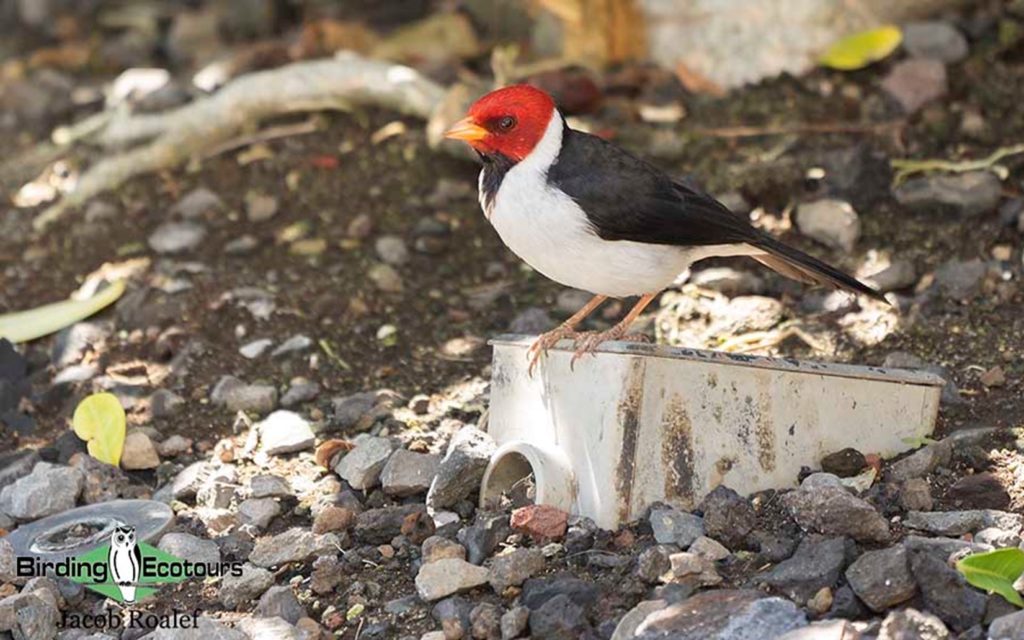
Bird List – Following IOC (12.1)
Birds ‘heard only’ are marked with (H) after the common name, all other species were seen. Species seen only on the pre-trip day of this trip are marked with (+) after the common name.
The following notation after species names is used to show conservation status following BirdLife International: CE = Critically Endangered, EN = Endangered, VU = Vulnerable, NT = Near Threatened.
| Common Name | Scientific Name |
| Ducks, Geese, Swans (Anatidae) | |
| Nene (Hawaiian Goose) (Endemic) – VU | Branta sandvicensis |
| Cackling Goose | Branta hutchinsii |
| Hawaiian Duck (Endemic) – EN | Anas wyvilliana |
| Lesser Scaup | Aythya affinis |
| New World Quail (Odontophoridae) | |
| California Quail (Introduced) | Callipepla californica |
| Pheasants & Allies (Phasianidae) | |
| Wild Turkey (Introduced) | Meleagris gallopavo |
| Common Pheasant (Introduced) | Phasianus colchicus |
| Kalij Pheasant (Introduced) | Lophura leucomelanos |
| Red Junglefowl (Introduced) | Gallus gallus |
| Grey Francolin (Introduced) | Ortygornis pondicerianus |
| Erckel’s Spurfowl (Introduced) | Pternistis erckelii |
| Sandgrouse (Pteroclidae) | |
| Chestnut-bellied Sandgrouse (Introduced) | Pterocles exustus |
| Pigeons, Doves (Columbidae) | |
| Rock Dove (Introduced) | Columba livia |
| Spotted Dove (Introduced) | Spilopelia chinensis |
| Zebra Dove (Introduced) | Geopelia striata |
| Mourning Dove (Introduced) | Zenaida macroura |
| Rails, Crakes & Coots (Rallidae) | |
| Common Gallinule | Gallinula galeata |
| Hawaiian Coot (Endemic) – VU | Fulica alai |
| Stilts and Avocets (Recurvirostridae) | |
| Black-necked Stilt (Hawaiian) | Himantopus mexicanus |
| Plovers (Charadriidae) | |
| Pacific Golden Plover | Pluvialis fulva |
| Sandpipers, Snipes (Scolopacidae) | |
| Bristle-thighed Curlew | Numenius tahitiensis |
| Ruddy Turnstone | Arenaria interpres |
| Sanderling | Calidris alba |
| Wandering Tattler | Tringa incana |
| Gulls, Terns, Skimmers (Laridae) | |
| Black Noddy | Anous minutus |
| White Tern | Gygis alba |
| Laughing Gull | Leucophaeus atricilla |
| Sooty Tern | Onychoprion fuscatus |
| Tropicbirds (Phaethontidae) | |
| Red-tailed Tropicbird | Phaethon rubricauda |
| White-tailed Tropicbird | Phaethon lepturus |
| Red-billed Tropicbird (Rarity) | Phaethon aethereus |
| Albatrosses (Diomedeidae) | |
| Laysan Albatross | Phoebastria immutabilis |
| Petrels, Shearwaters, Diving Petrels (Procellariidae) | |
| Juan Fernandez Petrel – VU | Pterodroma externa |
| Wedge-tailed Shearwater | Ardenna pacifica |
| Frigatebirds (Fregatidae) | |
| Great Frigatebird | Fregata minor |
| Gannets, Boobies (Sulidae) | |
| Red-footed Booby | Sula sula |
| Brown Booby | Sula leucogaster |
| Herons, Bitterns (Ardeidae) | |
| Black-crowned Night Heron | Nycticorax nycticorax |
| Western Cattle Egret (Introduced) | Bubulcus ibis |
| Kites, Hawks, Eagles (Accipitridae) | |
| Hawaiian Hawk (Io) (Endemic) | Buteo solitarius |
| Barn Owls (Tytonidae) | |
| American Barn Owl (Introduced) | Tyto furcata |
| Owls (Strigidae) | |
| Short-eared Owl | Asio flammeus |
| African & New World Parrots (Psittacidae) | |
| Red-masked Parakeet (Non-ABA) | Psittacara erythrogenyus |
| Old World Parrots (Psittaculidae) | |
| Rose-ringed Parakeet (Introduced) | Psittacula krameri |
| Rosy-faced Lovebird (Introduced) | Agapornis roseicollis |
| Monarchs (Monarchidae) | |
| Kauai Elepaio (Endemic) – VU | Chasiempis sclateri |
| Oahu Elepaio (Endemic) – EN | Chasiempis ibidis |
| Hawaii Elepaio (Endemic) – VU | Chasiempis sandwichensis |
| Larks (Alaudidae) | |
| Eurasian Skylark (Introduced) | Alauda arvensis |
| Bulbuls (Pycnonotidae) | |
| Red-whiskered Bulbul (Introduced) | Pycnonotus jocosus |
| Red-vented Bulbul (Introduced) | Pycnonotus cafer |
| Cettia Bush Warblers & Allies (Cettiidae) | |
| Japanese Bush Warbler (Introduced) | Horornis diphone |
| White-eyes (Zosteropidae) | |
| Warbling White-eye (Introduced) | Zosterops japonicus |
| Laughingthrushes & Allies (Leiothrichidae) | |
| Red-billed Leiothrix (Introduced) | Leiothrix lutea |
| Chinese Hwamei (Introduced) | Garrulax canorus |
| Greater Necklaced Laughingthrush (Introduced) (H) | Pterorhinus pectoralis |
| Mockingbirds, Thrashers (Mimidae) | |
| Northern Mockingbird (Introduced) | Mimus polyglottos |
| Starlings, Rhabdornis (Sturnidae) | |
| Common Myna (Introduced) | Acridotheres tristis |
| Thrushes (Turdidae) | |
| Oma‘o (Endemic) – VU | Myadestes obscurus |
| Chats, Old World Flycatchers (Muscicapidae) | |
| White-rumped Shama (Introduced) | Copsychus malabaricus |
| Old World Sparrows, Snowfinches (Passeridae) | |
| House Sparrow (Introduced) | Passer domesticus |
| Waxbills, Munias & Allies (Estrildidae) | |
| African Silverbill (Introduced) | Euodice cantans |
| Java Sparrow (Introduced) – EN | Padda oryzivora |
| Scaly-breasted Munia (Introduced) | Lonchura punctulata |
| Chestnut Munia (Introduced) | Lonchura atricapilla |
| Common Waxbill (Introduced) | Estrilda astrild |
| Red Avadavat (Introduced) (H) | Amandava amandava |
| Finches, Euphonias (Fringillidae) | |
| Palila (Endemic) – CR (H) | Loxioides bailleui |
| Iiwi (Endemic) – VU | Drepanis coccinea |
| Apapane (Endemic) | Himatione sanguinea |
| Akiapolaau (Endemic) – EN | Hemignathus wilsoni |
| Anianiau (Endemic) – VU | Magumma parva |
| Hawaii Creeper (Endemic) – EN | Loxops mana |
| Hawaii Akepa (Endemic) – EN | Loxops coccineus |
| Hawaii Amakihi (Endemic) | Chlorodrepanis virens |
| Oahu Amakihi (Endemic) – VU | Chlorodrepanis flava |
| Kauai Amakihi (Endemic) – VU | Chlorodrepanis stejnegeri |
| House Finch (Introduced) | Haemorhous mexicanus |
| Yellow-fronted Canary (Introduced) | Crithagra mozambica |
| Oropendolas, Orioles, Blackbirds (Icteridae) | |
| Western Meadowlark (Introduced) | Sturnella neglecta |
| Cardinals & Allies (Cardinalidae) | |
| Northern Cardinal (Introduced) | Cardinalis cardinalis |
| Tanagers & Allies (Thraupidae) | |
| Saffron Finch (Introduced) | Sicalis flaveola |
| Red-crested Cardinal (Introduced) | Paroaria coronata |
| Yellow-billed Cardinal (Introduced) | Paroaria capitata |
| Total Seen | 81 |
| Total Heard | 3 |
| Total Recorded | 84 |
This is a sample trip report. Please email us ([email protected]) for more trip reports from this destination.
